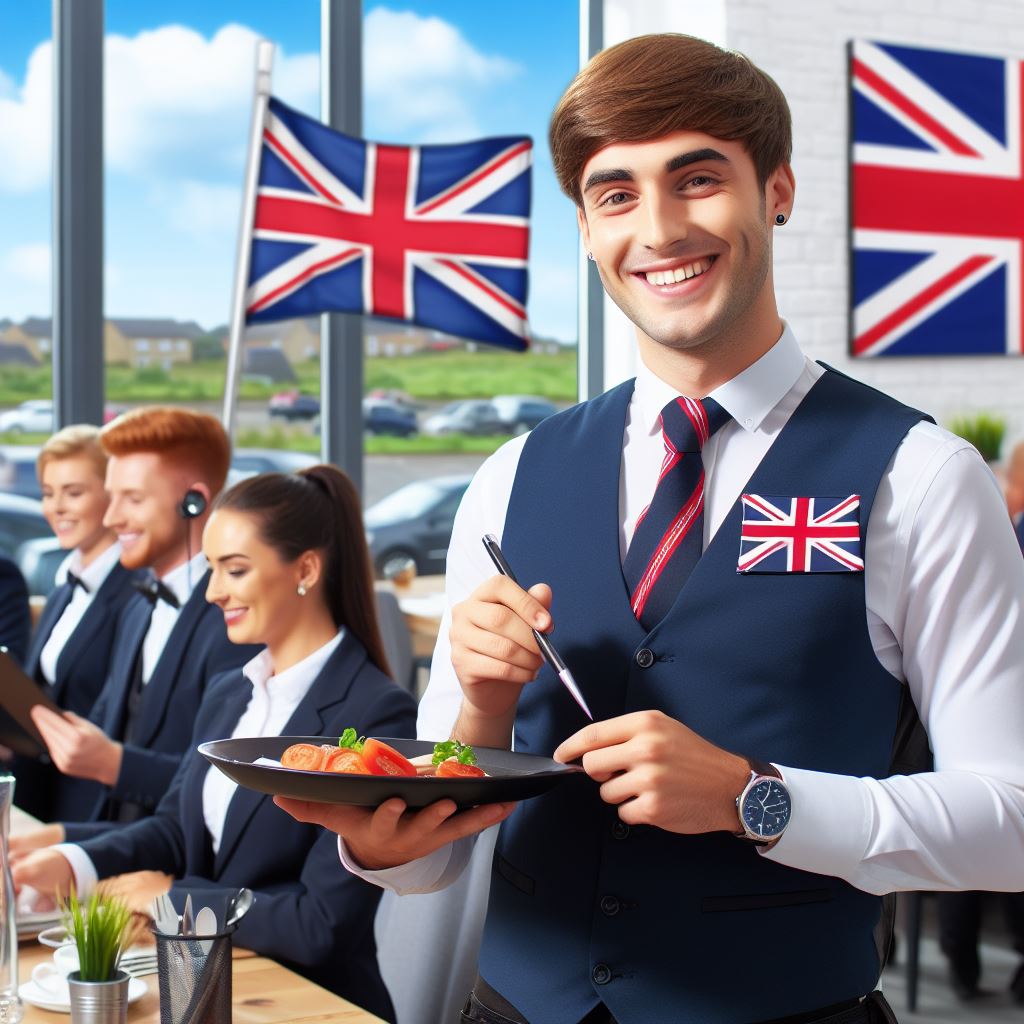Introduction
In the UK’s vibrant culinary landscape, the success of dining establishments significantly hinges on the competence of their waitstaff.
From fine dining to casual eateries, the quality of service provided directly correlates with customer satisfaction and repeat business.
Properly trained waitstaff not only enhance the customer experience but also contribute to the overall reputation and success of a restaurant.
Understanding the nuances of service, from menu knowledge to impeccable communication and conflict resolution, underscores the significance of comprehensive training methodologies.
In this section, we delve into the strategies, techniques, and approaches that reputable restaurants across the UK employ to ensure their waitstaff are well-prepared and adept at delivering outstanding service.
Join us as we explore the multifaceted realm of waitstaff training, uncovering the tried-and-tested practices that elevate service standards, foster customer delight, and elevate the dining experience throughout the United Kingdom.
Overview of the Waitstaff Training Process
Training Stages: From Hiring to On-the-Job Training
- When hiring waitstaff, it is important to select candidates with excellent communication and interpersonal skills.
- New hires should receive an orientation to familiarize them with the restaurant’s values, policies, and procedures.
- Basic training should cover topics such as customer service, menu knowledge, and proper hygiene practices.
- Once the basics are covered, trainees should be given hands-on experience during shadowing shifts.
- During on-the-job training, new waitstaff should be closely supervised and receive constructive feedback for improvement.
Importance of a Well-Structured Training Program
- A well-structured training program ensures consistency in service quality across all waitstaff.
- It helps inculcate the restaurant’s culture and values, leading to enhanced customer satisfaction.
- Proper training reduces mistakes, minimizes customer complaints, and improves overall operational efficiency.
- It enables waitstaff to handle challenging situations, such as dealing with difficult customers or handling emergencies.
- A comprehensive training program leads to waitstaff feeling valued, motivated, and engaged in their work.
Role of Managers and Trainers in the Training Process
- Managers play a crucial role in overseeing the training process and setting the right expectations.
- They should ensure that trainers are well-equipped to deliver effective training sessions.
- Trainers should have extensive knowledge of the restaurant’s operations and be skilled in imparting that knowledge to trainees.
- Regular communication between managers, trainers, and trainees is essential to address any issues or concerns.
- Managers and trainers should provide ongoing support and mentorship to waitstaff to promote their professional growth.
Need for Continuous Training and Development
- The hospitality industry is ever-evolving, with new trends, technologies, and customer expectations emerging.
- Continuous training ensures that waitstaff stay updated with the latest industry standards and best practices.
- Ongoing development programs help waitstaff enhance their skills, expand their knowledge, and improve their performance.
- It fosters a culture of continuous improvement and cultivates a highly skilled and competent waitstaff team.
- Regular training and development opportunities also contribute to employee retention and decrease turnover rates.
In fact, an effective waitstaff training process plays a crucial role in ensuring excellent service and customer satisfaction.
From hiring to on-the-job training, a well-structured program supported by managers and trainers is essential.
Continuous training and development further enhance the skills and knowledge of the waitstaff, enabling them to meet the evolving needs of the hospitality industry.
Recruitment and Selection
Importance of selecting the right candidates for waitstaff positions
- Choosing the right candidates is crucial to ensure excellent customer service and satisfaction.
- Skilled waitstaff contribute to a positive dining experience, which boosts the restaurant’s reputation.
- Having competent and well-trained waitstaff increases efficiency and helps in maintaining a smooth operation.
- By selecting the right candidates, turnover rates can be minimized, saving time and resources in the long run.
Skills and qualities to look for during the recruitment process
- Outstanding communication skills to effectively interact with customers and co-workers.
- Ability to multitask and remain composed in a high-pressure, fast-paced environment.
- Strong attention to detail to ensure accurate order taking and delivery.
- Friendly and approachable attitude that creates a welcoming atmosphere for guests.
- Excellent problem-solving skills to handle customer complaints and resolve issues efficiently.
- Knowledge of food and beverages, allowing for precise recommendations and menu descriptions.
- Physical stamina to handle long shifts and standing for extended periods.
- Positive attitude and team spirit to foster a harmonious work environment.
- Flexibility and adaptability to adjust to changing schedules and customer demands.
Use of interviews, resumes, and reference checks in the selection process
- Interviews play a crucial role in assessing a candidate’s personality, communication skills, and problem-solving abilities.
- Resumes provide information about a candidate’s experience, education, and relevant skills.
- Reference checks help verify a candidate’s work history, reliability, and overall performance.
- During interviews, it is essential to ask situational and behavioral questions to gauge a candidate’s aptitude.
- Consistency in the selection process ensures fairness and equal opportunities for all applicants.
- Considering both technical skills and interpersonal abilities helps identify well-rounded individuals.
- Thoroughly reviewing resumes helps identify candidates who possess the desired qualifications and experience.
- Reference checks provide insights into a candidate’s past performance, work ethic, and reliability.
- Conducting background checks further ensures the suitability and trustworthiness of potential hires.
In short, selecting the right candidates for waitstaff positions is of utmost importance in the UK.
Recruiting individuals with the necessary skills and qualities ensures exceptional customer service, boosts the restaurant’s reputation, and maintains efficiency.
Interviews, resumes, and reference checks are all valuable tools in the selection process, allowing employers to assess candidates effectively and make informed decisions.
By prioritizing recruitment and selection best practices, restaurants can build a strong and capable waitstaff team that contributes to their success.
Read: UK Waitstaff: Balancing Speed and Hospitality
Orientation and Onboarding
The Purpose of the Orientation Process for New Waitstaff Members
The orientation process is essential for new waitstaff members as it serves multiple purposes.
Firstly, it helps them become familiar with the establishment, its values, and culture.
Additionally, the orientation process helps integrate the new waitstaff members into the team and provides them with a clear understanding of their role and responsibilities.
Topics Covered During Orientation, such as Workplace Policies and Procedures
During orientation, new waitstaff members are introduced to various topics that are crucial for ensuring a smooth integration process.
They are informed about the establishment’s workplace policies, including codes of conduct, dress code, and health and safety regulations.
Furthermore, they receive training on important procedures such as cash handling, order taking, table service, and handling customer complaints.
The Importance of Providing Clarity on Job Expectations and Roles
It is crucial to provide new waitstaff members with clarity regarding job expectations and roles to ensure they understand their duties and responsibilities.
Clear communication regarding service standards, table etiquette, and customer interaction creates a foundation for delivering exceptional customer experiences.
By setting clear expectations, new waitstaff members are better equipped to meet and exceed customers’ needs, contributing to overall customer satisfaction.
Specific Training Materials or Resources Used During the Onboarding Process
During the onboarding process, various training materials and resources are utilized to facilitate the learning and development of new waitstaff members.
These may include training manuals, videos, role-playing exercises, and interactive modules.
Additionally, shadowing experienced waitstaff members allows new hires to observe and learn from seasoned professionals, gaining hands-on experience.
Providing written materials, such as handbooks and guides, ensures that crucial information is easily accessible to the new waitstaff members.
These resources can be referenced whenever needed, aiding in their ongoing training and development.
Furthermore, online platforms or learning management systems may be used to provide additional resources, assessments, and quizzes to reinforce learning.
Overall, the orientation and onboarding processes play a pivotal role in setting the foundation for waitstaff members to deliver exceptional service.
By familiarizing them with the establishment’s culture, policies, and procedures, new waitstaff members can integrate seamlessly into the team.
Clarity on job expectations and roles, combined with effective training materials and resources, empower waitstaff members to provide exceptional customer experiences and contribute to the success of the establishment.
Read: Waitstaff Training: Best Practices in the UK
Menu Knowledge and Product Training
The significance of waitstaff having thorough knowledge of the menu
- Train waitstaff to understand the ingredients and preparation methods of each dish.
- Encourage them to ask questions to clarify any uncertainties they may have.
- Ensure they can confidently describe each menu item to customers.
Best practices for menu training, including tastings and information sessions
- Organize regular tastings where waitstaff can sample the dishes on the menu.
- Provide detailed information about the flavors, textures, and presentation of each dish.
- Hold information sessions where chefs or managers explain the inspiration behind the menu.
Importance of educating waitstaff about ingredients, allergens, and dietary restrictions
- Ensure waitstaff can identify common allergens in each dish and suggest suitable alternatives.
- Provide them with knowledge about specific dietary restrictions and offer appropriate options.
- Train waitstaff to handle inquiries about allergens and dietary requirements with sensitivity.
Benefits of product training for offering recommendations and upselling
- Train waitstaff to suggest complementary dishes based on customers’ preferences and dietary needs.
- Encourage them to promote featured items or seasonal specials to increase sales.
- Provide product training on beverages, including wine pairings and cocktail recommendations.
Having waitstaff with extensive menu knowledge is crucial for providing exceptional service to customers.
By emphasizing the importance of menu training, you ensure that your staff can confidently answer questions, make recommendations, and accommodate various dietary restrictions.
Menu tastings and information sessions further enhance their understanding of the menu, enabling them to describe dishes in detail and provide a memorable dining experience.
Furthermore, educating waitstaff about ingredients, allergens, and dietary restrictions is essential for ensuring the safety and satisfaction of all customers.
By familiarizing them with common allergens and suitable alternatives, they can assist customers in making informed decisions.
Understanding specific dietary restrictions allows them to offer appropriate menu options tailored to individual needs and preferences.
Personalized UK Career Consulting
Receive tailored career guidance designed just for you. Get actionable steps and expert support to boost your career in 1-3 days. Take control of your career now.
Get StartedProduct training plays a significant role in enhancing the customer experience and increasing revenue.
By training waitstaff to make recommendations based on customers’ preferences and dietary needs, you create personalized dining experiences that leave a lasting impression.
Additionally, promoting featured items or seasonal specials through product training encourages waitstaff to upsell, driving sales and enhancing the overall dining experience.
In essence, menu knowledge and product training are integral parts of waitstaff training in the UK.
Emphasizing menu knowledge, conducting tastings and information sessions, educating about ingredients and allergens, and providing product training all contribute to delivering exceptional service and ensuring customer satisfaction.
By investing in comprehensive training programs, you empower your waitstaff to provide a memorable dining experience that keeps customers coming back for more.
Read: The Pay Scale: What UK Waitstaff Really Earn

Customer Service Training
The crucial role of customer service in the restaurant industry
- Customer service plays a vital role in the success and reputation of any restaurant.
- It directly impacts customer satisfaction and can determine whether they return or not.
- Good customer service leads to positive reviews, word-of-mouth recommendations, and increased business.
- It builds loyal customers who become regular patrons and contribute to the restaurant’s growth.
- Excellent customer service sets a restaurant apart from competitors and creates a competitive edge.
The importance of training waitstaff in effective communication skills
- Waitstaff are the frontline representatives of a restaurant and need excellent communication skills.
- Effective communication ensures that customer orders are received accurately and delivered properly.
- Waitstaff must be able to understand customer needs, answer questions, and make recommendations.
- Clear communication creates a pleasant and welcoming atmosphere, enhancing the overall dining experience.
- Training in communication skills helps waitstaff handle different customer preferences and diverse backgrounds.
Techniques for handling difficult customers and resolving conflicts
- Waitstaff should remain calm and composed when dealing with difficult customers.
- Active listening is crucial in understanding the customer’s concerns and finding appropriate solutions.
- Empathy and a positive attitude can de-escalate tense situations and turn them into positive experiences.
- Offering solutions, such as alternative menu options or discounts, shows a genuine effort to resolve conflicts.
- Waitstaff should involve a manager if the situation becomes unmanageable or requires higher authority intervention.
The significance of creating a positive dining experience for customers
- A positive dining experience leads to customer satisfaction and repeat business.
- It involves creating a warm and welcoming ambiance, ensuring cleanliness and hygiene.
- Attention to detail, like table settings and lighting, contributes to a pleasant dining atmosphere.
- Waitstaff should be attentive, proactive, and strive to exceed customer expectations.
- A positive dining experience encourages customers to leave positive reviews and recommend the restaurant to others.
In general, customer service plays a crucial role in the restaurant industry.
Training waitstaff in effective communication skills is essential for providing exceptional service.
Techniques for handling difficult customers and resolving conflicts ensure customer satisfaction.
Creating a positive dining experience is significant for customer retention and attracting new business.
By prioritizing customer service training, restaurants can differentiate themselves and thrive in a competitive industry.
Read: Waiter’s Guide: Handling Difficult Customers in the UK
Food and Beverage Service
Various service styles and techniques used in the UK
- The UK offers a range of service styles, including plate service, buffet service, and family-style service.
- Plate service involves carefully plating individual portions in the kitchen and serving them to guests.
- Buffet service allows guests to serve themselves from a variety of food options in a self-service setup.
- Family-style service involves serving large platters of food to the table for guests to help themselves.
- Other techniques used in the UK include gueridon service, where certain dishes are prepared tableside.
- Proper knowledge and training on each style and technique are essential for waitstaff to deliver an exceptional dining experience.
Importance of teaching proper table setting and service etiquette
- Table setting and service etiquette are crucial aspects of waitstaff training in the UK.
- Waitstaff must be knowledgeable about table settings, including the arrangement of cutlery, flatware, and glassware.
- Understanding the correct placement of serving dishes, napkins, and condiments is also important.
- Service etiquette involves teaching waitstaff about interpersonal skills, politeness, and professional conduct.
- Proper table setting and service etiquette contribute significantly to creating a positive dining atmosphere.
- Diners appreciate a well-set table and courteous service, enhancing their overall dining experience and satisfaction.
Significance of training waitstaff in wine and beverage service
- Waitstaff training in wine and beverage service is crucial for providing exceptional customer service.
- Waiters should have extensive knowledge about various wine types, regions, and food pairings.
- Understanding different beverage options and recommending suitable choices to guests is essential.
- Proper training ensures waitstaff can confidently answer customers’ questions and make informed recommendations.
- Waitstaff must also learn about serving techniques, such as decanting wine and proper pouring procedures.
- By mastering wine and beverage service, waitstaff can enhance the overall dining experience and customer satisfaction.
Role of waitstaff in coordinating with the kitchen for timely delivery of food
- The waitstaff play a crucial role in coordinating with the kitchen to ensure timely delivery of food orders.
- They must effectively communicate orders, special requests, and dietary restrictions to the kitchen staff.
- Waitstaff should continuously monitor cooking times and inform the kitchen about any necessary adjustments.
- They need to prioritize and organize food orders, ensuring the right dishes reach the appropriate tables promptly.
- Waitstaff should regularly check food quality and presentation before serving it to customers.
- By efficiently coordinating with the kitchen, waitstaff contribute to a smooth dining experience for guests.
In a nutshell, understanding the various service styles, teaching proper table setting and service etiquette, training waitstaff in wine and beverage service, and coordinating with the kitchen are all essential aspects of waitstaff training in the UK.
By mastering these skills, waitstaff can provide exceptional service, enhance the dining experience, and contribute to overall customer satisfaction.
Health and Safety Training
Health and safety training is an essential aspect of waitstaff training, ensuring the well-being of both employees and customers.
By educating waitstaff about best practices in maintaining a safe and hygienic environment, potential risks can be minimized, and overall customer satisfaction can be enhanced.
Importance of health and safety training for waitstaff.
Health and safety training equips waitstaff with the necessary knowledge and skills to identify and mitigate potential hazards.
This training enables them to maintain a safe workplace, prevent accidents, and promptly respond in emergency situations.
By understanding the importance of health and safety, waitstaff can contribute to a positive dining experience for customers and a healthy work environment for themselves.
The need to educate waitstaff about proper food handling and sanitation practices
Proper food handling and sanitation practices are crucial to prevent food contamination and reduce the risk of foodborne illnesses.
Educating waitstaff about these practices ensures that they handle food safely, maintain clean work surfaces, and follow hygiene protocols.
By understanding the importance of proper food handling and sanitation, waitstaff can maintain the health and well-being of customers and uphold the reputation of the establishment.
Requirements and certifications related to health and safety training in the UK
In the UK, waitstaff are required to obtain specific certifications related to health and safety training.
These certifications include Food Hygiene Level 2 and Health and Safety Level 2, which are recognized and mandated by regulatory authorities.
By completing these certifications, waitstaff demonstrate their competency in maintaining high standards of hygiene and safety in the foodservice industry.
Food Hygiene Level 2 training provides waitstaff with knowledge about proper food storage, temperature control, cross-contamination prevention, and personal hygiene.
This certification ensures that employees understand the fundamentals of safe food handling and are aware of the potential risks associated with poor sanitation practices.
Health and Safety Level 2 training focuses on identifying hazards in the workplace, implementing safety measures, and responding to emergencies.
This certification equips waitstaff with the skills to recognize potential risks, promote a safe work environment, and minimize accidents or injuries.
In addition to these certifications, establishments in the UK are required to have a documented food safety management system, such as a Hazard Analysis and Critical Control Points (HACCP) plan.
This system ensures that appropriate measures are in place to maintain food safety and hygiene standards.
Generally, health and safety training for waitstaff is essential to maintain a safe and hygienic dining environment.
By educating waitstaff about proper food handling, sanitation practices, and obtaining relevant certifications, establishments can ensure the well-being of both employees and customers, while upholding industry regulations and standards.
Your Dream Job Starts with a Perfect CV
Get a tailored CV and cover letter that captures your unique strengths and stands out in your industry. Let us help you make an unforgettable first impression.
Get StartedYou Might Also Like: Holiday Trends: A Consultant’s Perspective
Continuous Training and Development
Continuous training and development play a crucial role in the success of waitstaff in the UK.
In an industry that is constantly evolving, it is essential for waitstaff to stay updated with the latest trends and acquire new skills to deliver exceptional service.
Ongoing training not only benefits the waitstaff but also contributes to the overall growth and success of the establishment.
Importance of ongoing training and development for waitstaff
- Continuous training ensures that waitstaff are equipped with the necessary knowledge and skills to perform their job effectively.
- It helps them stay updated with the latest industry practices, menu items, and customer preferences.
- Ongoing training also enhances their ability to handle difficult situations, such as dealing with demanding customers or handling conflicts in the workplace.
- Training provides waitstaff with the confidence and competence necessary to deliver exceptional customer service, resulting in customer satisfaction and loyalty.
- It also helps waitstaff adapt to changes in the dining experience, such as implementing new technology or health and safety protocols.
Benefits of investing in additional courses and certifications
- Additional courses and certifications provide waitstaff with specialized knowledge and skills, such as wine pairing, mixology, or allergen awareness.
- Such certifications can set waitstaff apart from their peers and enhance their career prospects, opening up opportunities for higher positions or increased income.
- Investing in additional courses demonstrates the commitment of the establishment to providing high-quality service, attracting discerning customers who appreciate well-trained staff.
- Continuous learning also boosts the confidence of waitstaff and instills a sense of pride in their profession.
- Certifications in areas like food safety or responsible alcohol service help ensure compliance with legal requirements, protecting the establishment from potential liabilities.
Role of managers in providing feedback and coaching for improvement
- Managers play a crucial role in observing the performance of waitstaff and providing constructive feedback for improvement.
- Regular feedback sessions help waitstaff understand their strengths and areas that require further development.
- Managers can identify individual training needs and recommend suitable courses or workshops to enhance specific skills.
- Coaching sessions assist waitstaff in practicing and refining their service techniques, ultimately improving the overall dining experience for customers.
- Regular communication and supportive coaching create a positive work environment and foster a culture of continuous improvement among the waitstaff.
Therefore, continuous training and development are essential for waitstaff in the UK.
Ongoing training not only ensures that waitstaff are equipped with the necessary skills but also enhances their career prospects and contributes to the success of the establishment.
Managers play a vital role in providing feedback and coaching, creating a culture of continuous improvement and delivering exceptional service.
Conclusion
In the UK’s hospitality industry, waitstaff training forms the backbone of exceptional service.
It’s not merely about serving food or beverages; it’s a symphony of skills and professionalism.
Emphasizing the importance of thorough training, we’ve delved into various practices that can transform the dining experience.
The crux lies in continual learning, adapting, and honing skills to meet evolving customer needs.
Encouraging establishments to embrace this ethos, the aim is not just satisfactory service but to exceed expectations.
The dedication to ongoing training not only benefits the establishment but also empowers the staff, fostering a culture of excellence.
As you navigate the realm of hospitality, remember, investing in training isn’t just an expense; it’s an investment in success and customer satisfaction.
Keep refining, keep evolving—let your service speak volumes.
[E-Book for Sale]
500 Cutting-Edge Tech Startup Ideas for 2024 & 2025: Innovate, Create, Dominate
$19.99 • 500 Tech Startup Ideas • 62 pages
You will get inspired with 500 innovative tech startup ideas for 2024 and 2025, complete with concise descriptions to help you kickstart your entrepreneurial journey in AI, Blockchain, IoT, Fintech, and AR/VR.




